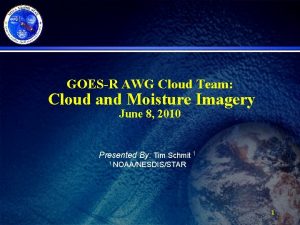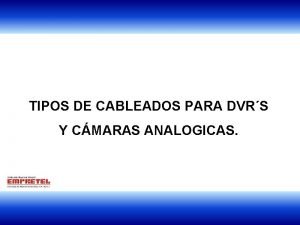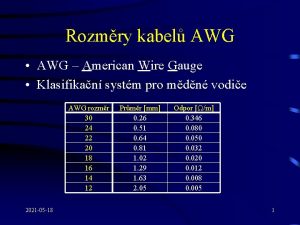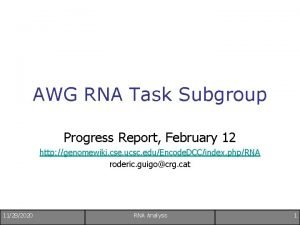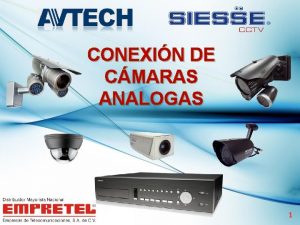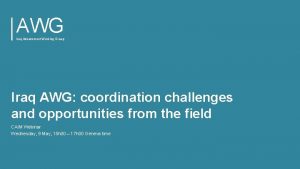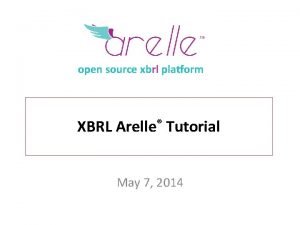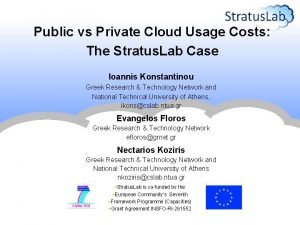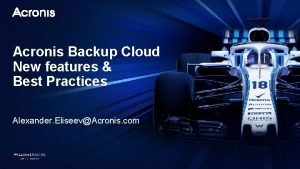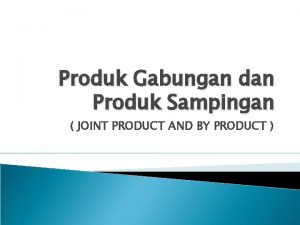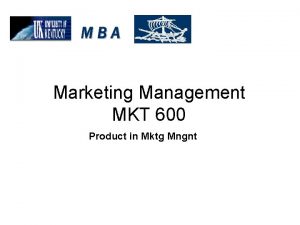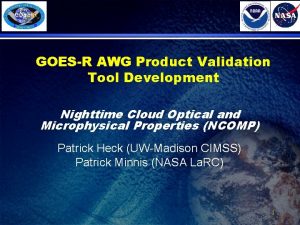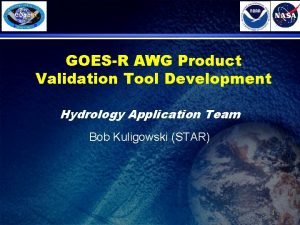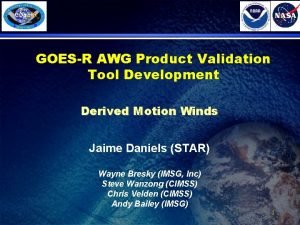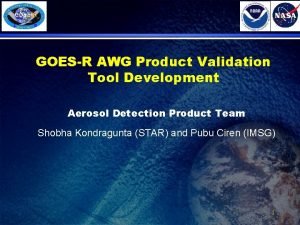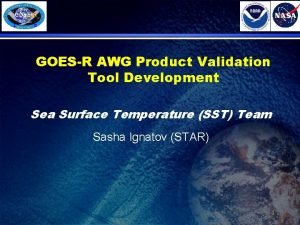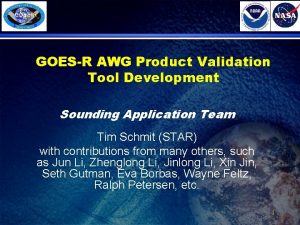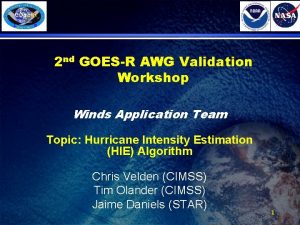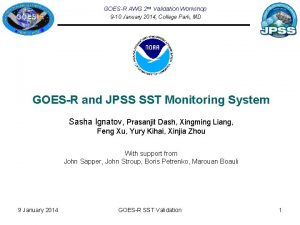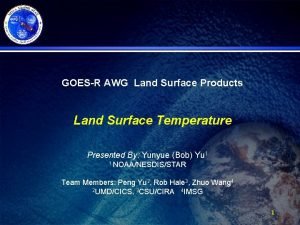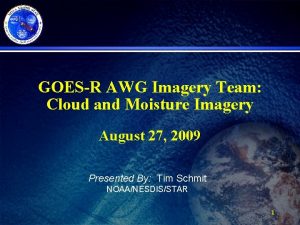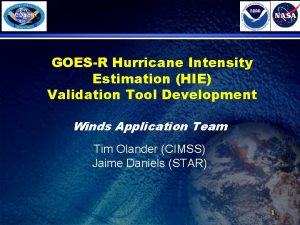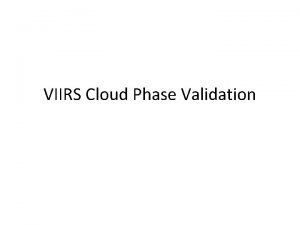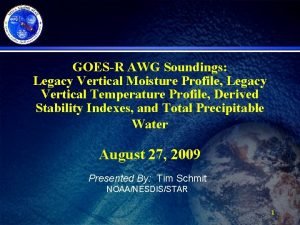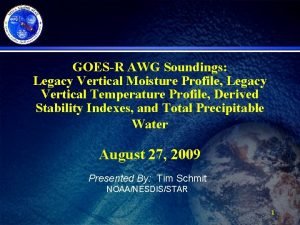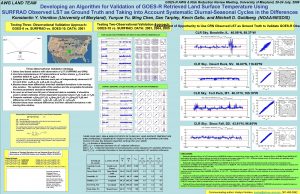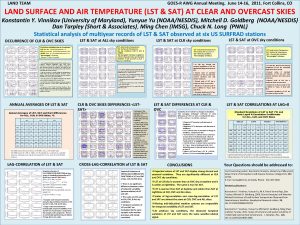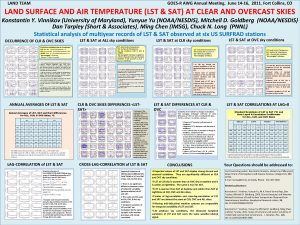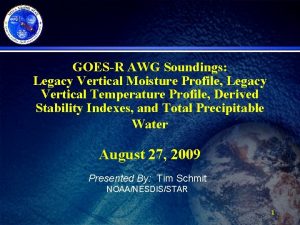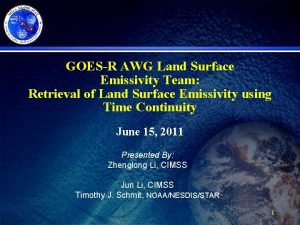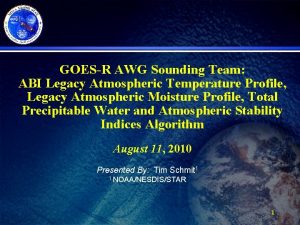GOESR AWG Product Validation Tool Development Cloud Products


























- Slides: 26

GOES-R AWG Product Validation Tool Development Cloud Products Andrew Heidinger (STAR) Michael Pavolonis (STAR) Andi Walther (CIMSS) Pat Heck and Pat Minnis (NASA Larc) William Straka (CIMSS) 1

OUTLINE • Products (1 -2 slides) • Validation Strategies (3 -4 slides) • Routine Validation Tools (4 -5 slides) • “Deep-Dive” Validation Tools (4 -5 slides) • Ideas for the Further Enhancement and Utility of Validation Tools (1 -2 slides) • Summary 2

Cloud Products While the cloud team as 10 products from 5 algorithms, we really have 14 when comes to validation. 1. 2. 3. 4. 5. 6. 7. 8. 9. 10. 11. 12. 13. 14. Clear sky mask (binary, 4 -level, and test results) Cloud Phase Cloud Type Cloud-top Height Cloud-top Temperature Cloud-top Pressure Daytime Cloud Optical Depth Daytime Cloud Particle Size Daytime Liquid Water Path Daytime Ice Water Path Nighttime Cloud Optical Thickness Nighttime Cloud Particle Size Nighttime Liquid Water Path Nighttime Ice Water Path 3

Validation Strategies • Cloud Phase/Type – A-train – CALIPSO and potentially Cloud. Sat • ABI Cloud Height Algorithm (ACHA) – CALIPSO cloud-top height – MODIS CO 2 slicing results • Daytime Cloud Optical and Microphysical Properties (DCOMP) – Comparison to same products from other algorithms on similar sensors – Microwave radiometers (AMSRe) provide Liquid Water Path – Various data-sets from field campaigns. • Nighttime Cloud Optical and Microphysical Properties (NCOMP) – Microwave radiometers (AMSRe) provide Liquid Water Path – CALIPSO to provide cloud optical depth for thin cirrus. • Validation tools needed – All Deep-Dive tools developed in IDL and development continues – Routine validation imagery done in IDL and prototype websites exist showing images using Java Applets and Google Earth. – Mc. Idas-V interaction beginning. 4

Validation Strategy Summary Cloudsat CALIPSO AMSRe ARM Surf. Rad mask ✔ ? phase ✔ ? height ? ✔ Direct Field Campaigns ✔ ? d. cod ✔ ✔ d. ceps ✔ d. lwp ? d. iwp ? n. cod ✔ ? ✔ n. ceps n. lwp ? n. iwp ? ✔ ✔ 5

Routine Validation Tools Cloud Phase/Type • Visual analysis – Cloud Type – Easiest to perform in an operational manner. Visualization below from the CIMSS GEOCAT website. Images generated in IDL. – Cloud phase and type should visually correlate with features seen in false color images that include the appropriate channels. 6

Routine Validation Tools Cloud Height • While product images coupled with false color images do not provide the direct validation offered for cloud mask and cloud phase/type, they are still important parts of any routine cloud validation tools. • For example, cloud height, pressure, temperature (shown below) should be visually consistent with IR imagery or suitable false color imagery. • Imagery shows performance of clouds near edges and across boundaries. 7

Routine Validation Tools Cloud Water Path • Cloud Water Path (Liquid or Ice) should show a correlation with the visible reflectance. • Areas of very low values over bright surface are indicative of false cloud. • Imagery shows performance of clouds near edges and across boundaries. 8

Routine Validation Tools Cloud Water Path • Cloud Effective Particle Size (CEPS) should show a correlation with cloud phase with water particles generally being smaller than ice cloud particles. • Imagery shows performance of clouds near edges and across boundaries. • Artifacts along lines of constant sensor or solar zenith angle can indicate errors in reading of the lookup tables. 9

Deep Dive: Comparison with Same Products from Similar Sensors (Direct) • Most of the GOES-R cloud product suite is standard to all major processing activities from EUMETSAT, NASA and NOAA. • There remain areas of considerable difference in the methods used to estimate cloud properties by various groups. The GOES-R Cloud Team has participated in several workshops run by EUMETSAT where these differences were explored. • For most products, there are not standard accepted methods for the retrieval and comparison of our results to those from other well-respected groups are valuable. • The MODIS science team data has proven especially valuable and convenient since it is free and easy to obtain. 10

W G P R O D U C T S (D C O M P ) Deep Dive Comparison to MODIS Example: DCOMP Comparison to NASA MODIS MYD 06 Products (One Granule 22: 40 UTC on August 1, 2009) OPTICAL DEPTH N A S A EFFECTIVE RADIUS (mm) M O D I S P R O D U C T S WATER PATH (g/m 2) ( M Y D 0 6 ) 11 11

Deep Dive Validation with CALIPSO: Ice Cloud Optical Depth • Validation of ice cloud depth is more challenging because passive microwave sensors do not detect most of the ice clouds and ice scattering properties are more uncertain in the vis/nir spectral region. • CALIPSO can provide an accurate estimate of cirrus optical depth for a subset of observations (thin cirrus at night bounded by molecular returns). • This allows us to validate the cloud optical depth from ACHA (an IP – top figure) • And consequently to DCOMP via ACHA during the day. • Note this analysis was done with MODIS optical depths but can and will be done with DCOMP 12

Deep Dive: Comparison with CALIPSO/Cloud. Sat • CALIPSO provides very direct measurements of the cloud-top and cloud boundaries for moderately thick clouds. • The CALIPSO Phase Product in the latest version (3. 01) is also useful. • CALIPSO may not be around in the GOES-R era, but similar capabilities should be available. • The Cloud Height Validation is transitioning to use the UW/SSEC CALIPSO matchup files for SEVIRI. 13

Deep Dive: Comparison with CALIPSO/Cloud. Sat 14

Deep-Dive Validation DCOMP Liquid water path with AMSRe • • ABI cloud water content algorithm is based on retrievals of particle size and optical thickness Passive microwave observations are directly influenced by liquid water within clouds. Microwave algorithms are only possible over ocean due to low and homogonous emissivity values Since LWP is calculated by CPS and COD, LWP validation supports evaluation of these two parameters as well. 3/3/2021 15

Deep-Dive Validation DCOMP Liquid water path with AMSRe • The Advanced Microwave Scanning Radiometer - Earth Observing System (AMSR-E) is capable to retrieve liquid water path above ocean surface. • Spatial resolution : 10 x 15 km for LWP product with a swath of approx. 1450 km. Example of daily coverage AMSR-E observations From http: //www. remss. com/ 16 16

Deep-Dive Validation DCOMP Liquid water path with AMSRe • There a number of recent publications about validation of MODIS LWP with AMSR-E. (Greenwald 2009 : bias of up to 60% in Tropics) • Use here a concept by Juarez et al. 2009: • LWPDCOMP = CLF x CWPDCOMP • CLF – Cloud liquid fraction in AMSR FOV • CWPDCOMP – Cloud water path (ice and liquid) in AMSR-E FOV • Matching criteria for AMSR-E • Master grid : AMSR-E, slave grid: DCOMP • 90% of cloudy DCOMP pixels within a AMSR-E FOV must be liquid. • CTT > 268 K to exclude potential ice particles • Mask out thin clouds (COD<5) • Mask out all pixels with Rain flag in AMSR-E data 17 17

Deep-Dive Validation DCOMP Liquid water path with AMSRe DCOMP LWP (SEVIRI) AMSR-E LWP • Example for 2007 day 106 (16 April 2007) • DCOMP shows only pixels with liquid phase fraction of 1. in a 20 x 20 km vicinity 18 18 • DCOMP: 13: 02 -13: 04 UTC / AMSR-E : 12: 59 – 13: 03

Deep-Dive Validation DCOMP Liquid water path with AMSRe · Image shows result of four arbitrary chosen days in October 2006 and April 2007. · Accuracy and precision specs are met. 19 19

Deep Dive: Field Campaigns • Field campaigns provide in-situ measurements of cloud properties that are not available anywhere else • Field campaigns tend to provide multiple estimates of cloud parameters from various airborne and surface instruments (radar, lidar, ir-interferometers, shortwave – spectrometers and microwave radiometers). • Field campaigns also provided access to detailed information to help understand characterize the performance of the satellite retrievals. • We expect field campaigns to occur with GOES-R but existing data with taken during the pre-GOES-R era is useful since we applied GOES-R algorithms to current sensors. 20

Deep Dive: Field Campaigns • • • The SSFR is a shortwave spectrometer operated by U. Colorado / LASP. During CALNEX 2010 it was operated on a ship looking up. It provides retrievals of DCOMP cloud properties using radiation that travelling through the cloud (not reflected off the top like DCOMP). This provides a more independent validation. For example, CEPS from SSFR is much lower than DCOMP due to particle size variation in water clouds (top figure). However, DCOMP accounts for this in estimating the cloud Liquid Water Path (LWP) and good agreement is seen in the SSFR / DCOMP LWP (bottom figure). 21

Deep Dive: Surface Radiation (Surf. Rad) • Surf. Rad is a network of surface radiation mearsurement sites. They measure upward and downward broadband solar and IR fluxes. • One of the intermediate products of DCOMP is the hemispheric cloud transmission at 0. 65 microns. (It is a required variable in the retrieval of optical depth and particle size). • It should be highly correlated to the measured all-sky transmission (the ratio of the red to black lines in the bottom figure). • These stations are numerous and provide an integrated view of cloudiness. 22

Deep Dive: DCOMP Validation with Surface Radiation (Surf. Rad) • The figures on the left show the results of a comparison of DCOMP on the AVHRR run through PATMOS-x for one year of NOAA 18 data and all 8 Surf. Rad sites. • The results indicate the all-sky transmission from DCOMP (based on the cloud optical depth and the cloud mask) show little bias and a high correlation. • Same analysis being repeated for GOES which will provide many more samples. 23

Deep-Dive Tools: AVAC-S • AVAC-S (A-Train Validation of Aerosol and Cloud properties from SEVIRI ) is a IDL-based software package funded by EUMETSAT which matches data products from A-TRAIN sensors and ancillary data ( also model output) to a common grid. • AVAC-S includes many tools for scene identification, sub-setting and data merging to support validation scenarios, statistical appraisal and visual inspection. • May be used as deep-dive and routine Cal/Val tool • Extension to global capability is planned 24 24

Ideas for the Further Enhancement and Utility of Validation Tools • Coordinated development of CALIPSO/Cloud. Sat tools – There are many options when it comes to doing analysis with co-located CALIPSO and passive satellite sensors. – The ACM and ACHA team have tested sample output from the AWGfunded UW/SSEC co-location team and developed a version of the CALIPSO validation tool. – AVACS tool from EUMETSAT offers capabilities that we have not fully exploited. – Mc. Idas-V is another option. • Routine Validation Images that allow for overlaying products on top of imagery are useful. This capability is not common in NESDIS operations and perhaps AWG should develop a common site or set of images just like EUMETSAT does. 25

Summary • The Cloud Team is using every data source type available for validation. • Tools are being developed independently in IDL mainly but we are open to Mc. IDAS-V especially if that leads to routine validation images. • The cloud team has multiple web-sites where GOES-R AWG cloud products are visualized. • A common look web-site with deep-dive validation results is the next step. 26
 Awg cloud
Awg cloud Awg norfolk ne
Awg norfolk ne Tabla de awg amperaje
Tabla de awg amperaje Awg tabulka
Awg tabulka Awg aken
Awg aken Awg norfolk ne
Awg norfolk ne Cable 18 awg amperaje
Cable 18 awg amperaje Awg
Awg Xbrl arelle
Xbrl arelle Product life cycle kotler
Product life cycle kotler Functional and innovative products
Functional and innovative products Pepsi product mix
Pepsi product mix Cloud computing refers to
Cloud computing refers to Cloud to cloud integration patterns
Cloud to cloud integration patterns Public cloud vs private cloud cost analysis
Public cloud vs private cloud cost analysis Cloud disaster recovery cloud snap
Cloud disaster recovery cloud snap Cloud verification tool acronis
Cloud verification tool acronis Potter's wheel data cleaning tool
Potter's wheel data cleaning tool Oracle cloud product lifecycle management
Oracle cloud product lifecycle management Product breakdown structure tool
Product breakdown structure tool Contoh produk sampingan
Contoh produk sampingan Average product of labor
Average product of labor Types of product line
Types of product line Core augmented and actual product
Core augmented and actual product Dot vs cross product
Dot vs cross product Management prowess example
Management prowess example Overview definition
Overview definition
